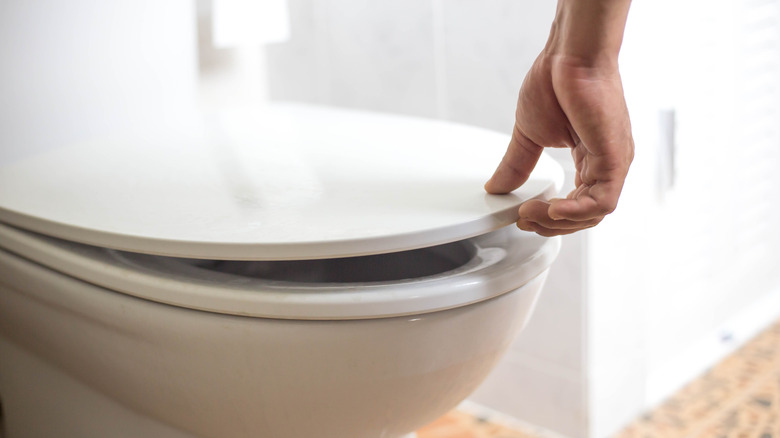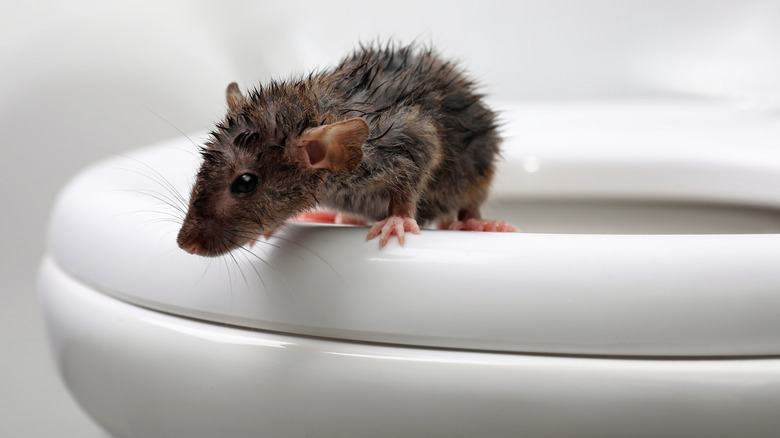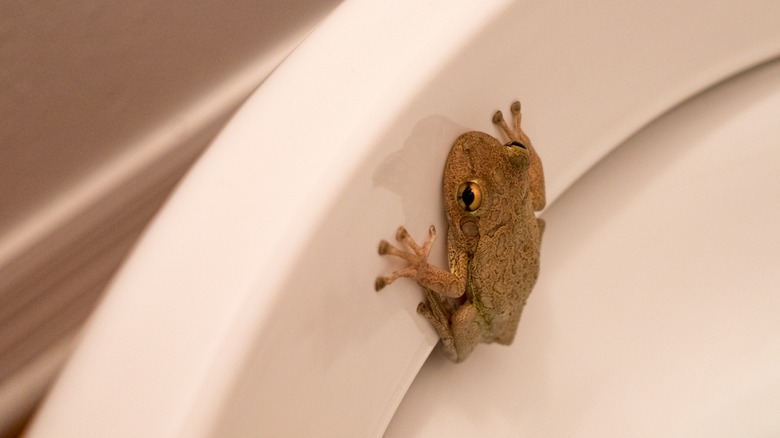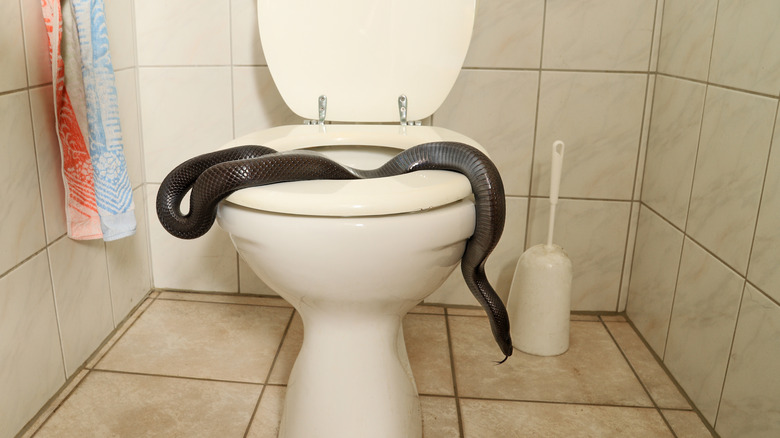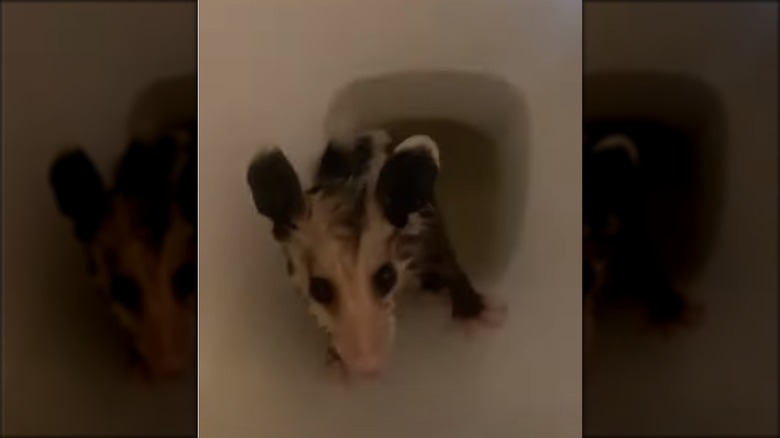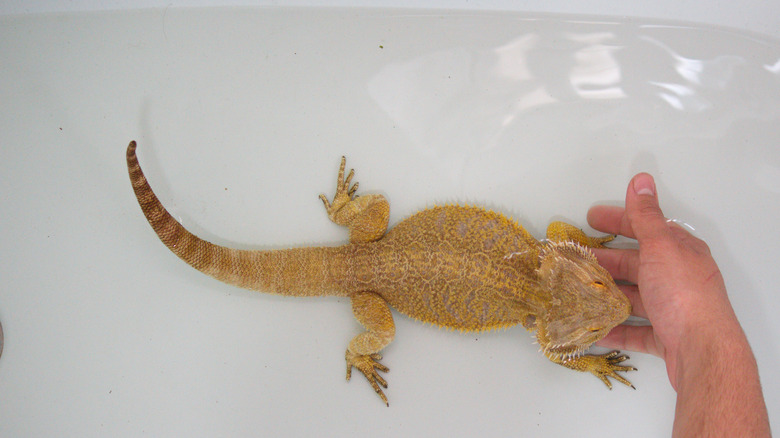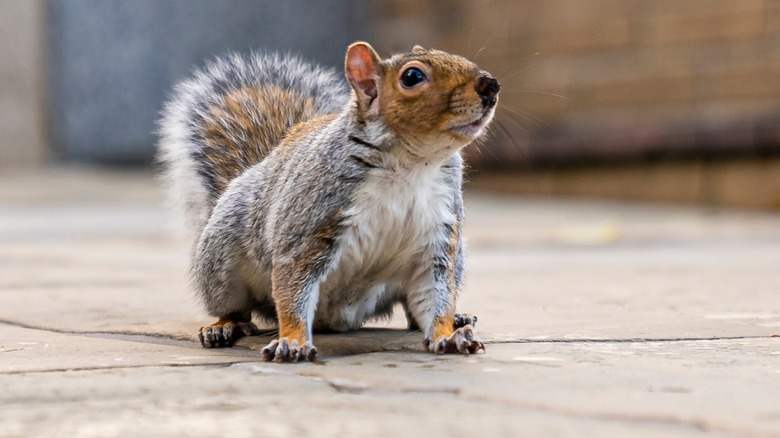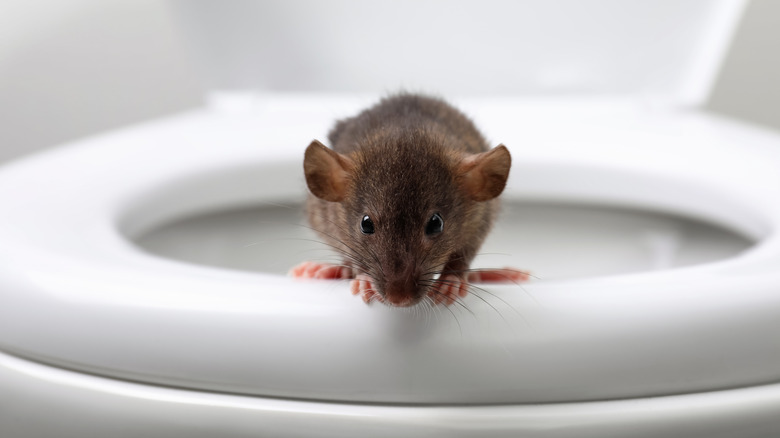Common House Pests That May Be Sneaking Inside Through Your Toilet (And How To Prevent Them)
Imagine walking into your bathroom just like any other day. But, unlike every other time you use the toilet, this time when you open the lid you find yourself staring right into the eyes of an animal or an insect. Needless to say, your first reaction will likely be to slam the lid back down and keep whatever creature you discovered from getting out. After that's done — and after the initial fright and shock wears off — the next thing you'll do is wonder what exactly you were looking at. What animal got into your bowl, and how did it end up there?
Unfortunately, this is not just the stuff of horror movies. While it isn't all that common, some pests do enter a home through the toilet. Some seek out the damp environment, while others accidentally find their way into the pipes and are simply looking for a way out. Either way, you'll want to know which pests have the potential to break in through the bowl, and, more importantly, what you can do to stop them from getting in and giving you the fright of your life.
Rats can swim through a home's pipe and exit through the toilet
A rat in your toilet? As unpleasant as this sounds, it is possible. Rats are good swimmers, so finding their way up into a toilet isn't that much of a challenge for them. Remember, your toilet pipes connect to the sewer. As gross as it sounds, they are attracted to the smell of human waste. So, if there is any crack or break in the sewer line or the drain pipe in your yard, the rat has found its "in." Once in the main line, it can swim around, find its way to the pipe leading up to the toilet itself, and voilà, there it is.
Beyond the absolute horror of opening the toilet lid to discover a rat, they can pose a risk to your home. Rats carry diseases and could spread them if they get out into the house. Trying to simply flush the pest back "where it came from" isn't a good option either, as it could clog the pipe. Instead, you'll want to contact a qualified professional to remove the rat for you. Once the immediate problem is resolved, consider hiring a plumber or sewer repair company. They can look for an opening that lets the rat in and repair the lines so that other intruders don't find their way inside again.
Frogs may enter a home's vent stack and find their way to the nearest toilet
If you open the lid of the toilet and find yourself face-to-face with a frog, know that that's not an uncommon occurrence. While rats intentionally get into a toilet seeking out the pleasant (to them) scent of human waste, frogs that wind up inside the loo are more likely there accidentally. The most likely explanation is that it was jumping around by the roof and fell into the vent stack (or main vent pipe) for the home. Because the vent stack connects with toilet pipes, it's only a matter of time before it makes it into the toilet itself.
After you (carefully) get the frog out of your toilet (or hire a professional if you aren't comfortable doing so yourself), there are a few things you can do to stop future hopping friends from dropping in for a quick visit. Start by trimming the branches of your trees back from the house. Doing so will make it less likely that a frog will find its way onto your roof in the first place. Then, you can use some chicken wire or something similar to cover the top of the vent pipe on the roof. This will further block other frogs from jumping down and finding their way into the bathroom.
Snakes may slither in through toilet pipes
Believe it or not, there are a few different ways that a snake could find its way into your toilet. They could enter through an open door, window, or crack in the house itself, but the chances of them slithering into the bathroom and then up and into the toilet aren't all that great. It would be more likely for them to get in through the vent stack on the roof, much in the same way that a frog would enter. If you have tree branches that are right up against your roof, the snake could crawl from the branch to the roof and find the vent pipe. They might decide that it looks like a safe space to take shelter or decide to go exploring in search of food. Like rats, snakes may also find an opening in the sewer lines or a home's septic tank and swim through the pipes to the toilet. However, this would more likely be a water snake because not all serpents could stay below the water for that long.
Trust a professional to remove a snake from your toilet; this is likely not something you'll want to attempt on your own. Then, take steps to make sure that your sewer lines and septic tanks don't have any openings or cracks that will allow other slithering creatures to get through. You can hire a plumber to send a camera down the pipes to look for such breaks. Trim trees back from the house and block access to the vent stack as well.
Possums can enter through sewer line openings
A few years ago, the CBS news channel in San Diego, California, shared a story about a woman who opened the toilet in her apartment to find a baby possum inside the bowl. Naturally, seeing a critter in her toilet was scary and confusing for the poor woman. However, this wasn't a completely isolated incident. There are other reports of people opening their toilets to discover a possum — baby or adult — looking back at them. Like other pests, these marsupials may gain entry through an open vent stack on the roof or even through a sewer pipe.
Fortunately, possums are not aggressive and don't pose a serious threat, so you should be able to remove them from the toilet yourself (if you're up to the task). However, their presence could pose another threat. The animals could become stuck in the pipe, resulting in a clogged toilet. After getting them out of the bowl, take measures to make sure that others don't find their way in. This will involve using chicken wire to cover the vent stack, trimming back long branches that are too close to the roof, and repairing any openings in the sewer lines around the house.
Lizards sometimes find their way into toilet bowls because they're looking for water
Yet another creature that may find its way into your home through the toilet is a lizard. Of course, finding one of these in your bathroom throne will be most likely if you live in an area where they are more common. Many lizards like water. If one finds its way up on your roof, it will be able to smell the water through the vent stack. It may decide to seek out the water and end up dropping down the vent stack. From there, like other pests, the lizard will realize that the only way to get themselves out of their current predicament is to climb up through the pipes to the toilet bowl.
You don't want to get bitten by a scared lizard, so act with caution if you find one in your toilet bowl. Unless you feel confident and qualified to remove it, consider reaching out to a professional pest management company. Then, follow the steps recommended above to deny future lizards access to the vent stack by trimming back trees and covering the opening with chicken wire.
Squirrels may inadvertently find their way into a home's toilet
After reading about some of the other animals that can sneak in through a toilet, it might not be that surprising to learn that squirrels may also enter a home in a similar fashion. That vent stack on your roof is, once again, likely to blame if you have a squirrel in the toilet. Squirrels are good climbers and can get up onto a home's roof by climbing over from nearby tree branches. Once up there, all they have to do is get curious enough to end up going down the vent stack. After dropping down, the squirrel will be searching for a way to get out. They'll see some light filtering through your bathroom, and scurry up to the bowl.
While running across a squirrel outside your home isn't likely to pose any real threat, it will be a different situation if you encounter one inside your toilet. The animal is likely to be scared and feel threatened by your presence, which means that they may try to bite or become otherwise aggressive. The safest option would be to call an exterminator, who will be able to safely remove the pest from the toilet for you. Then, follow the steps shared above to block access to the vent stack to prevent the rest of the squirrel's family from ending up back in your bathroom.
Mice may enter a toilet through a home's vent stack, too
No one wants to hear that their basement is infested with mice. Similarly, no one wants to open up their toilet lid to find themselves face-to-face with one of these tiny rodents. Alas, finding one in your toilet is possible, though not too likely. If a mouse gets up onto your roof and falls through the vent stack, chances are they're going to try to climb up through the toilet, following the light coming in through the lid. Mice are good at climbing and swimming, so making their way up the toilet pipes won't be an impossible feat for them.
As with other pests, take caution if you discover a mouse in your toilet. If you're feeling brave enough to try to catch the rodent, be sure to don protective clothing and a pair of gloves. After remediating the problem, cover the vent stack with chicken wire and cut back overhanging trees. It is probably also a good idea to look for signs of mice in other areas of your home, just in case the critter actually found its way in from within the house.
